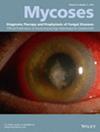Impact of COVID-19 on paracoccidioidomycosis. Which was the most influential: The pandemic or the virus?
IF 4.1
2区 医学
Q1 DERMATOLOGY
引用次数: 0
Abstract
The impact of COVID-19 on paracoccidioidomycosis (PCM) in Argentina and the consequences generated by the pandemic are discussed. From 2018 to 3 years after the pandemic declaration, 285 proven PCM patients were registered. No association between both diseases was documented. PCM frequency decreased to extremely low levels in 2020. Mandatory social isolation and the emotional and psychological effects generated under pandemic circumstances led to delays in diagnosis, severe disseminated cases, and other challenges for diagnosis in subsequent years. Probable underdiagnosis should be considered due to the overlap of clinical manifestations, the low index of suspicion and the lack of sensitive diagnostic tools.
COVID-19 对副球孢子菌病的影响。哪种影响最大?大流行还是病毒?
本文讨论了 COVID-19 对阿根廷副球孢子菌病(PCM)的影响以及大流行造成的后果。从 2018 年到大流行宣布后的 3 年间,共登记了 285 名经证实的 PCM 患者。这两种疾病之间没有关联。2020 年,肺结核发病率降至极低水平。强制性社会隔离以及大流行情况下产生的情绪和心理影响导致了诊断延误、严重的传播病例以及随后几年诊断方面的其他挑战。由于临床表现重叠、怀疑指数低和缺乏敏感的诊断工具,应考虑可能存在诊断不足的情况。
本文章由计算机程序翻译,如有差异,请以英文原文为准。
求助全文
约1分钟内获得全文
求助全文
来源期刊

Mycoses
医学-皮肤病学
CiteScore
10.00
自引率
8.20%
发文量
143
审稿时长
6-12 weeks
期刊介绍:
The journal Mycoses provides an international forum for original papers in English on the pathogenesis, diagnosis, therapy, prophylaxis, and epidemiology of fungal infectious diseases in humans as well as on the biology of pathogenic fungi.
Medical mycology as part of medical microbiology is advancing rapidly. Effective therapeutic strategies are already available in chemotherapy and are being further developed. Their application requires reliable laboratory diagnostic techniques, which, in turn, result from mycological basic research. Opportunistic mycoses vary greatly in their clinical and pathological symptoms, because the underlying disease of a patient at risk decisively determines their symptomatology and progress. The journal Mycoses is therefore of interest to scientists in fundamental mycological research, mycological laboratory diagnosticians and clinicians interested in fungal infections.
 求助内容:
求助内容: 应助结果提醒方式:
应助结果提醒方式:


